May 4, 2020 feature
Exciton resonance tuning of an atomically thin lens
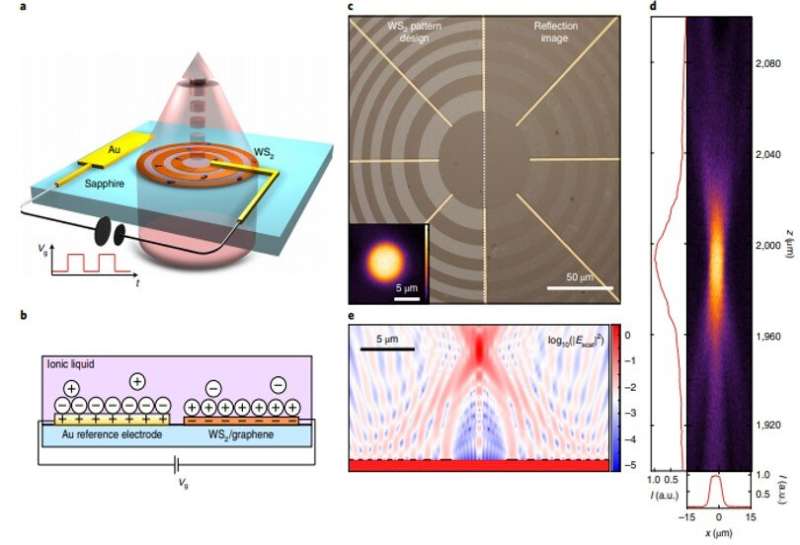
Since the development of diffractive optical elements in the 1970s, researchers have increasingly uncovered sophisticated fundamental principles of optics to replace the existing bulky optical elements with thin and lightweight counterparts. The attempts have recently resulted in nanophotonic metasurfaces that contain flat optics made of dense arrays of metal or semiconductor nanostructures. Such structures can effectively control the local light scattering phase and amplitude based on plasmonic or Mie resonances. Scientists have studied the two types of resonances to realize small-form-factor optics that deliver multifunctionality and control across the light field. While such metasurface functions have remained static, it is highly desirable to achieve dynamic control for emerging photonic applications such as light direction and ranging (LIDAR) for 3-dimensional (3-D) mapping. Plasmonic and Mie resonances only offer weak electrical tunability, but decades of research on optical modulation describe exciton manipulation to be stronger to control optical properties of a material.
The critical role excitons can play during optical wavefront manipulation remains to be understood and demonstrated with atomically thin optical elements. In a new study now published on Nature Photonics, Jorik van de Groep and a team of researchers in Advanced Materials at Stanford University and the College of Optics and Photonics at the University of Central Florida, U.S. engineered an atomically thin optical element that can be actively controlled. They carved the substrate directly from a monolayer of tungsten disulfide (WS2). The material showed strong excitonic resonance in the visible spectral range. Instead of the typical approach to engineer the size and shape of geometrically resonant antennas, the team designed the metasurfaces made from 2-dimensional (2-D) excitonic materials by modifying the material's resonance. By optimizing the arrangement of 2-D materials, they achieved specific optical functions—to realize resonant and tunable light-matter interactions.
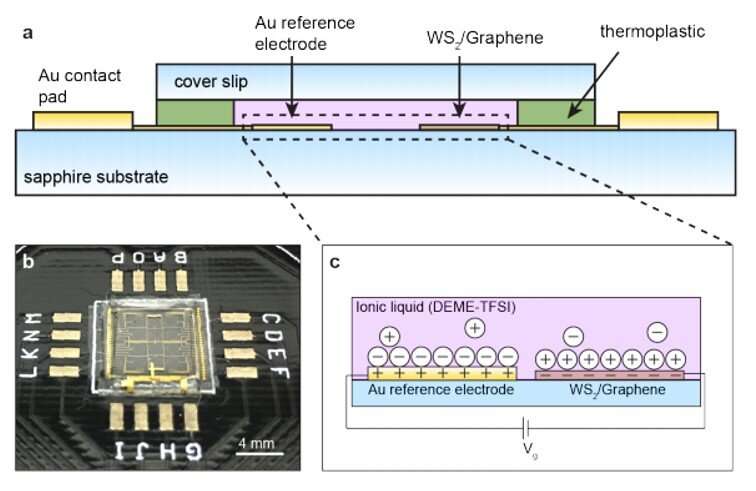
Tunable atomically thin zone plate lens
To highlight the importance of exciton resonances in the operation of the flat lens, the team viewed the rings of WS2 as the sources of scattered fields, driven by an incident plane wave. The locally generated scattered fields were proportional to the polarization of the WS2 material, the scientists expected the strongest scattering near the exciton resonance, where the magnitude of complex electric susceptibility (denoted x) was largest. The experimental setup accomplished substantially higher focusing efficiencies with higher-quality exfoliated materials in which the exciton linewidth was notably reduced.
While this lens was virtually invisible to the human eye for non-resonant wavelengths, it could capture important information from its surroundings for the intensity in the focus to well exceed the intensity of the incident plane wave. Spectral dependence of the focusing efficiency depended on the complex material susceptibility of the WS2 monolayer. The scientists could not experimentally isolate the scattered field, but they collected the weakly scattered light from a large area to determine the focal intensity of the experimental zone plates to be high and largely based on the WS2 material.
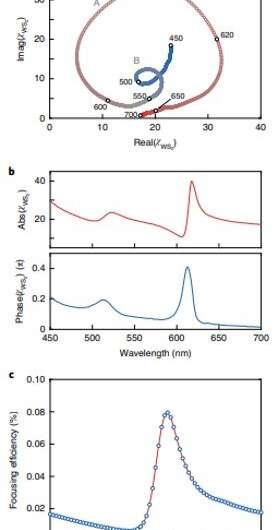
Exciton resonance tuning and focal intensity modulation
The team controlled the focusing efficiency of the lens by altering the exciton resonance of the WS2 material using electrical gating. For this, they analyzed the induced reflectivity changes from a simple 20 x 20 µm2 square patch isolated from monolayer WS2, as a function of the applied gate voltage. They observed a complete removal of the excitonic resonances to produce one of the largest possible changes in susceptibility. This exciton suppression was also fully reversible and highly reproducible. The observations highlighted the benefits of excitonic resonances compared to plasmonic and Mie-type resonances that are both harder to tune and suppress.
The researchers then capitalized on the large tunability of the exciton resonances to control the intensity in the focal spot of a lens. They experimentally measured the power in the focus as a function of the wavelength normalized to the power incident on the zone plate lens to understand the focusing efficiency spectrum. The results indicated that focussed excitonic light scattering dominated the direct substrate transmission. When the team applied a 3-volt gate bias to the WS2/graphene heterostructure to suppress the exciton resonance, they observed full suppression of the asymmetric excitonic line. Then using reversible switching of the exciton resonance, they restored the neutral resonant state.
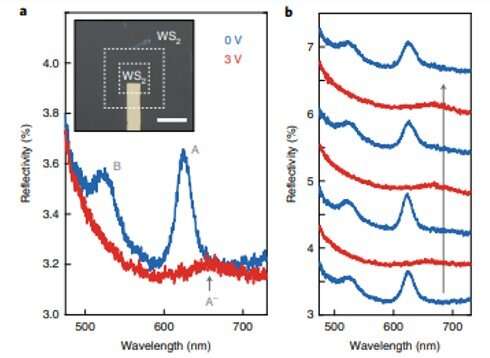
The results were consistent with the observation of linewidth narrowing in reflection measurements on the patch devices. The measured focusing efficiency was relatively low and limited due to the relatively low material quality of the commercial WS2. For instance, high quality encapsulated monolayers of small flake molybdenum diselenide (MOSe2)can achieve an optical reflectance of up to 80 percent. Scientists can therefore improve the large-area growth of high-quality monolayer transition metal dichalcogenides (TMDCs) such as WS2 to strongly enhance the focusing efficiencies.
The research team conducted room temperature, large-area active manipulation of the exciton resonance to demonstrate dynamic light intensity control in the focus of the 2-D material zone plate lens. They reproducibly switched between the exciton-dominated and exciton-quenched states to accomplish active control on the excitonic light scattering amplitude. The response time and asymmetry in the setup resulted from ion-transport limited complex formation and due to the disassembly of the ionic-liquid electrical double layer. As a result, the scientists propose to implement solid-state gating schemes instead of ionic-liquid gating to increase the device response time by orders of magnitude, which is currently limited due to fabrication challenges.
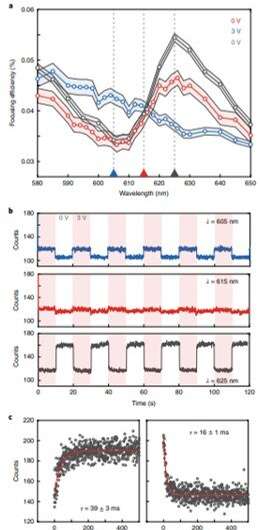
In this way, Jorik van de Groep and colleagues demonstrated the importance of excitonic material resonances to operate atomically thin optical lenses. They envision that more advanced gating schemes with local and interleaved gating electrodes will facilitate excitonic optical devices with more complex functionalities such as tunable focal lengths or beam steering. The work opens an entirely new approach to design dynamic flat optics and metasurfaces for applications in free-space beam tapping, wavefront manipulation and in augmented/virtual reality.
More information: Jorik van de Groep et al. Exciton resonance tuning of an atomically thin lens, Nature Photonics (2020). DOI: 10.1038/s41566-020-0624-y
Mohammadreza Khorasaninejad et al. Metalenses: Versatile multifunctional photonic components, Science (2017). DOI: 10.1126/science.aam8100
Shuming Wang et al. A broadband achromatic metalens in the visible, Nature Nanotechnology (2018). DOI: 10.1038/s41565-017-0052-4
Journal information: Nature Photonics , Science , Nature Nanotechnology
© 2020 Science X Network





















